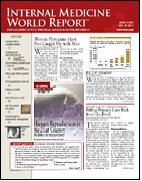Publication
Article
Internal Medicine World Report
H Pylori Eradication, COX-2 Inhibitors Use Reduce Hospitalizations for Complicated Ulcers
H Pylori Eradication,COX-2 Inhibitors Use Reduce Hospitalizations for Complicated Ulcers
New Orleans—Hospitalization rates for complicated ulcers have decreased significantly, particularly in older adults, according to data presented at Digestive Disease Week. The sharpest declines in hospitalizations for complicated ulcer disease have coincided with a national recommendation for Helicobacter pylori eradication and the introduction of cyclooxygenase (COX)-2 inhibitors.
The largest inpatient care database in the United States was used to examine hospitalization trends due to complicated gastric and duodenal ulcers over a 14-year period. The database comprised about 85% of all US hospitalization discharges and included nearly 500 million hospitalizations and 3.6 billion person-years of observation from 1988 to 2001.
During that period, a primary diagnosis of gastric ulcer, duodenal ulcer, or peptic ulcer accounted for 2.2 million hospitalizations, a 0.44% of all hospitalizations. And while the total number of all-cause hospitalizations increased from 35 million in 1988 to 37 million in 2001, the number of complicated ulcer hospitalizations decreased from 166,725 to 139,597.
“Hospitalizations in the United States have gone up as the population is aging,” said Gurkirpal Singh, MD, of Stanford University, Calif. “Yet hospitalizations for upper GI [gastrointestinal] complications as a primary diagnosis have been going down.”
The first decline occurred in 1994-95 when the National Institutes of Health declared H pylori to be a class 1 carcinogen and recommended its eradication when found. “The second sharp decline occurred in 1999 and coincided with the introduction of COX-2 inhibitors,” said Dr Singh.
The 1994-95 decline was 11%, and was predominantly related to a reduction in complicated duodenal ulcers, further bolstering the notion that eradication of H pylori was responsible for the decline in hospitalizations for complicated ulcers because duodenal ulcer risk is strongly associated with H pylori infection.
The steep decline, about 8%, in 1999 was mainly a result of a reduction in complicated gastric ulcer hospitalizations. “Gastric ulcer is associated with use of nonsteroidal anti-inflammatory drugs [NSAIDs], and even though the total number of NSAID prescriptions has almost doubled, we were able to show a drop in GI complications,” said Dr Singh.
The number of hospitalizations per 100,000 NSAID prescriptions dropped 11% in 1994-95 and 22% in 1999; a small proportion of this decline was attributed to the introduction of proton pump inhibitors and the remainder to the introduction of COX-2 inhibitors.
“Fascinating enough, as the penetration of COX-2 inhibitors has slowed in recent years, so has the decline in hospitalizations,” Dr Singh said. In looking at hospitalization trends from 1998 to 2001, he found a flattening of age-specific complicated ulcer hospitalizations except in individuals >55 years of age who had a lower incidence rate from 1998 to 2001.
The database also revealed that hospitalizations for a primary diagnosis of gastric, duodenal, or peptic ulcer are fairly stable up until age 50 to 55 years, when they rose in an exponential fashion. Increasing age also exponentially increased the case fatality rate from complicated ulcer disease; case fatality rates are about 1% in 40- to 45-year olds and rise to 2.5% at age 70 to 75 years.
These data suggest that increasing age should be an important factor for implementing ulcer prevention strategies and aggressive therapies, Dr Singh said.
